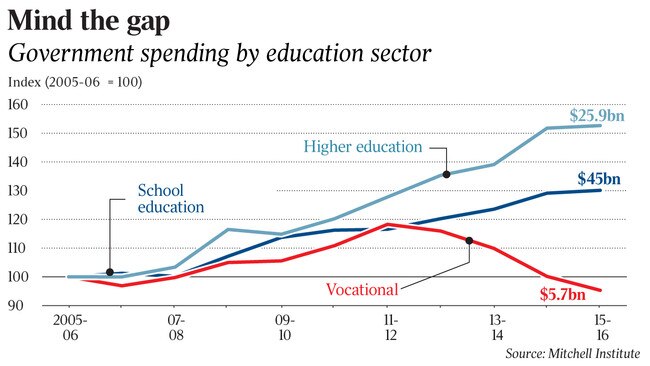‘Poor cousin’ VET’s funding keeps falling
Training’s share of education spending has plummeted 30 per cent, as VET reels from a bipartisan trashing.

Training’s share of education spending has plummeted by 30 per cent in a little over a decade, as vocational education and training reels from a bipartisan and multi-jurisdictional trashing.
The Mitchell Institute’s latest snapshot of education spending highlights a yawning chasm in tertiary education.
“Last year we reported that VET expenditure had plummeted to its lowest point in 10 years,” director Megan O’Connell said.
“This year it has dropped even further. We could be setting up a very uncertain future for Australia, since many predicted growth areas for jobs require vocational qualifications.”
The report, based on Australian Bureau of Statistics figures, found that higher education spending in 2015-16 was 52 per cent above that for 2005-06. Spending on schools was up 30 per cent over the 11 years, in line with growing student numbers and wage inflation.
Meanwhile, VET spending had fallen by 4.7 per cent, or $280 million, when adjusted for inflation. And while the growth rate in schools and universities had “stabilised” to about 1 per cent in the last year of the analysis, the bleeding in VET had grown to 5 per cent.
Ms O’Connell said the lack of coherent education policies had spawned “disjointed” approaches to investing in the nation’s future.
“It is staggering that despite all the evidence for a strong VET system, governments still treat it as the poor cousin of universities,” she said.
Demands for an integrated approach to tertiary education funding, a major recommendation of the 2008 Bradley review of higher education, have intensified in recent months.
A new book by University of Melbourne vice-chancellor Glyn Davis backs it as a priority reform to “future proof” Australian tertiary education.
Departing Queensland University of Technology vice-chancellor Peter Coaldrake has also highlighted “joining up” post-school learning as the overriding policy priority.
Insecure funding has helped create havoc at public training providers — especially TAFE SA, where last week’s suspension of 14 of 16 randomly audited courses could be the tip of the iceberg.
A report released on Friday by Victoria’s Independent Broad-based Anti-corruption Commission found that systemic weaknesses at two TAFEs had allowed a subcontractor to pocket $2m for non-existent training.
The latest financial report on VET, released late last month, showed that the sector’s operating funding had crashed by 17 per cent last year alone. Mitchell analyst Peter Noonan said VET was suffering “planned disinvestment”, particularly from the states, whose collective contribution had fallen by a third, or $1.45 billion, in just four years.
Professor Noonan said the federal government’s proposed Skilling Australians Fund would not solve the problem because the states would meet the requirement to match its allocations by extracting money from their other VET activities.
He said the only solution was for the commonwealth to replace the main intergovernmental funding agreement, the National Agreement for Skills and Workforce Development, which provides the states and territories with about $1.5bn in recurrent funding every year.
“How much worse do things have to get before governments finally decide that enough is enough and something has to happen?” he asked.
“The commonwealth has got to stop focusing on VET FEE-HELP and the SAF and broaden the conversation out to funding the whole sector. It has to take leadership through the Council of Australian Governments and get a completely new funding agreement and system in place.”



To join the conversation, please log in. Don't have an account? Register
Join the conversation, you are commenting as Logout